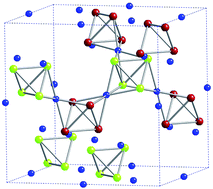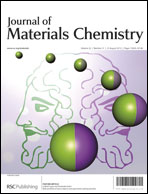Magnetic properties of Fe2GeMo3N; an experimental and computational study
Abstract
A polycrystalline sample of Fe2GeMo3N has been synthesized by the reductive nitridation of a mixture of binary oxides in a flow of 10% dihydrogen in dinitrogen. The reaction product has been studied by magnetometry, neutron diffraction and Mössbauer spectroscopy over the temperature range 1.8 ≤ T/K ≤ 700. The electronic structure and magnetic coupling have been modelled by Density Functional Theory (DFT) and Monte Carlo methods. Fe2GeMo3N adopts the cubic η-carbide structure with a = 11.1630(1) Å at 300 K. The electrical resistivity was found to be ∼0.9 mΩ cm over the temperature range 80 ≤ T/K ≤ 300. On cooling below 455 K the compound undergoes a transition from a paramagnetic to an antiferromagnetic state. The magnetic unit cell contains an antiferromagnetic arrangement of eight ferromagnetic Fe4 tetrahedra; the ordered atomic magnetic moments, 1.90(4) μB per Fe atom at 1.8 K, align along a <111> direction. DFT predicts an ordered moment of 1.831 μB per Fe. A random phase approximation to the DFT parameterised Heisenberg model yields a Néel temperature of 549 K, whereas the value of 431 K is obtained in the classical limit for spin. Monte Carlo calculations confirm that the experimentally determined magnetic structure is the lowest-energy antiferromagnetic structure, but with a lower Néel temperature of 412 K. These results emphasise the potential of these computational methods in the search for new magnetic materials.


 Please wait while we load your content...
Please wait while we load your content...